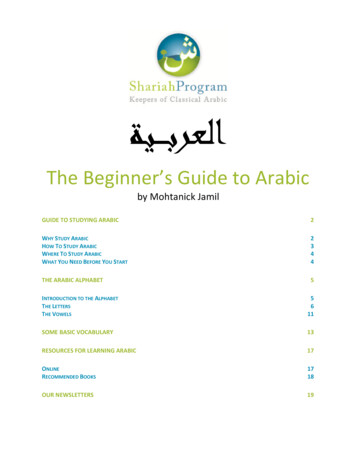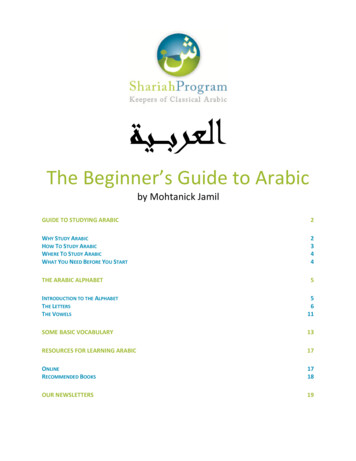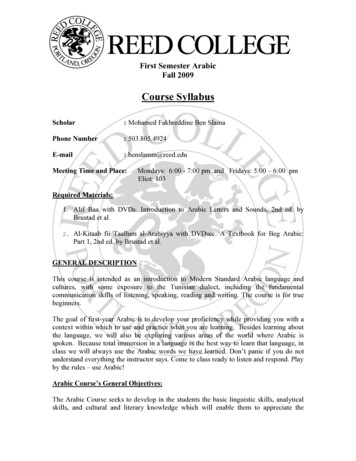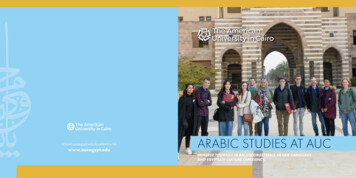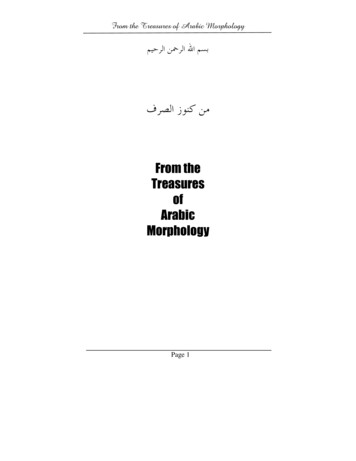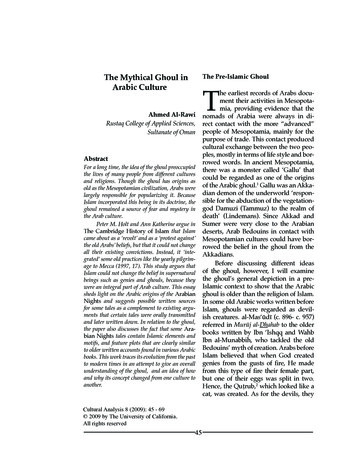
Transcription
Mythical Ghoul in Arabic CultureThe Mythical Ghoul inArabic CultureThe Pre-Islamic GhoulAhmed Al-RawiRustaq College of Applied Sciences,Sultanate of OmanAbstractFor a long time, the idea of the ghoul preoccupiedthe lives of many people from different culturesand religions. Though the ghoul has origins asold as the Mesopotamian civilization, Arabs werelargely responsible for popularizing it. BecauseIslam incorporated this being in its doctrine, theghoul remained a source of fear and mystery inthe Arab culture.Peter M. Holt and Ann Katherine argue inThe Cambridge History of Islam that Islamcame about as a ‘revolt’ and as a ‘protest against’the old Arabs’ beliefs, but that it could not changeall their existing convictions. Instead, it ‘integrated’ some old practices like the yearly pilgrimage to Mecca (1997, 17). This study argues thatIslam could not change the belief in supernaturalbeings such as genies and ghouls, because theywere an integral part of Arab culture. This essaysheds light on the Arabic origins of the ArabianNights and suggests possible written sourcesfor some tales as a complement to existing arguments that certain tales were orally transmittedand later written down. In relation to the ghoul,the paper also discusses the fact that some Arabian Nights tales contain Islamic elements andmotifs, and feature plots that are clearly similarto older written accounts found in various Arabicbooks. This work traces its evolution from the pastto modern times in an attempt to give an overallunderstanding of the ghoul, and an idea of howand why its concept changed from one culture toanother.Cultural Analysis 8 (2009): 45 - 69 2009 by The University of California.All rights reserved45The earliest records of Arabs document their activities in Mesopotamia, providing evidence that thenomads of Arabia were always in direct contact with the more “advanced”people of Mesopotamia, mainly for thepurpose of trade. This contact producedcultural exchange between the two peoples, mostly in terms of life style and borrowed words. In ancient Mesopotamia,there was a monster called ‘Gallu’ thatcould be regarded as one of the originsof the Arabic ghoul.1 Gallu was an Akkadian demon of the underworld ‘responsible for the abduction of the vegetationgod Damuzi (Tammuz) to the realm ofdeath’ (Lindemans). Since Akkad andSumer were very close to the Arabiandeserts, Arab Bedouins in contact withMesopotamian cultures could have borrowed the belief in the ghoul from theAkkadians.Before discussing different ideasof the ghoul, however, I will examinethe ghoul’s general depiction in a preIslamic context to show that the Arabicghoul is older than the religion of Islam.In some old Arabic works written beforeIslam, ghouls were regarded as devilish creatures. al-Mas‘ūdī (c. 896- c. 957)referred in Murūj al-Dhahab to the olderbooks written by Ibn ‘Ishqq and WahbIbn al-Munabbih, who tackled the oldBedouins’ myth of creation. Arabs beforeIslam believed that when God createdgenies from the gusts of fire, He madefrom this type of fire their female part,but one of their eggs was split in two.Hence, the Quṭrub,2 which looked like acat, was created. As for the devils, they
Ahmed Al-Rawisame place after few hours, however, hecould not find the ghoul there (Ibid.).In addition, Abū Asīd al-Sa‘dī mentioned the story of Arqam Bin Abū alArqam in which a ghoul appeared andkidnapped al-Arqam’s, son who was ona desert journey. The ghoul, disguisedin the form of a woman, carried the boyon its back. When they saw al-Arqam’sfriend, the woman pretended to be theboy’s attendant (al-Wâqidī 1984, 104).This story emphasizes the well-knowndeceitful and wicked character of theghoul. In folktales, motif (G443.2) ‘Ogreabducts woman’s children ’ (El-Shamy1995, 149) is similar to the account givenabove. In general, the Pre-Islamic ghoulis known as a devilish female creaturethat intends to inflict harm on travelersand is able to change its form. In mostcases, the ghoul is defeated by strikingit with a sword.6 The following sectiondiscusses how the ghoul has been associated with Islamic practices.came from another egg and settled inthe seas. Other evil creatures, such as theMârid,3 inhabited the islands; the ghoulresided in the wilderness; the si‘lwahdwelt in lavatories and waste areas; andthe hâmah4 lived in the air in the form ofa flying snake (1986, 171).al-Qazwīnī (c.1208-c.1283) mentioned a different description takenfrom an old Arabic source, which saysthat when the devils wanted to eavesdrop on Heaven, God threw meteors atthem,5 whereupon some were burnt, fellinto the sea and later turned into crocodiles, while others dropped onto theground and changed into ghouls (1980,236). Such descriptions cannot be foundin Islamic texts. For instance, Abū ‘Uthmân al-Jâhiẓ (c. 775- c. 868), who compiled many popular beliefs in his bookal-Ḥaywân (The Animal), wrote that commoners thought that the devil’s eyeswere upright as in images taken from theBedouins (1969, 214), whose ideas livedon for almost two thousand years.As for popular tales, several stories dealing with the ghoul circulatedbefore Islam. For instance, ‘Umar Binal-Khaṭṭâb (c. 586-644), the second Muslim Caliph, was known as the man whokilled a ghoul in the desert when he wastraveling to Syria. After stopping him,the female monster asked the man: ‘Binal-Khaṭṭâb, where are you heading?’The Caliph answered: ‘This is not yourconcern,’ and the ghoul turned its headcompletely around in order to frightenhim (Ibn Manẓūr vol. xxvii, 269-70).Knowing the evil intentions of the monster, Bin al-Khaṭṭâb raised his sword andkilled it by striking it between its shoulder and neck. When he returned to theThe Islamic GhoulWhen Islam firstly spread in the ArabianPeninsula in the seventh century, it succeeded in changing many old customs,such as ending the habit of burying recently born baby girls and preventingwomen from marrying more than oneman at a time. It could not, however,change other ideas such as the belief inthe ghoul or the si‘lwah (si‘lah).7 Prophet Muhammed mentioned the ghoul inseveral of his sayings, but later Muslimscholars had conflicting views about theauthenticity of these sayings, as somenegated the ghoul’s existence and othersconfirmed it. Despite the rational voicesthat rejected the existence of this mon-46
Mythical Ghoul in Arabic Culturester, many Arabs (especially Bedouins)narrated tales and recited poetry thatfeatured or mentioned the ghoul. Sincethis creature originated in the desert, itwas particularly popular there from thepre-Islamic period until present time.However, the legend spread to the Arabs’ urban areas and became part of theculture there, which suggests that theBedouins’ beliefs were very influential,and in some cases formed the very fabricof the Arab society. As mentioned earlier,Holt and Katherine’s argument that Islam could not change all the old beliefsof Arabia is valid in the case of belief inthe ghoul.Prophet Muhammed himself wassaid, in many instances, to comment onor confirm the existence of ghouls. Forexample, Ismâ‘īl bin ‘Umar Abū al-Fidâ’(?- c. 1372) mentioned in Tafsīr Ibn Kathīrthat ghouls were the ‘demons of genies’,and cited the following famous incident:When the Prophet met his companionAbū Dharr in a mosque, the Prophetadvised Abū Dharr to pray in order tobe saved from the mischief of the devilsof humans and genies. Abū Dharr wassurprised to hear the Prophet confirmedthe existence of creatures such as these,which the Prophet identified as ghouls(1980, 306-8).In another anecdote, Abū Ayūb alAnşârī asked the Prophet’s advice because some ghouls used to eat from hisdates store at night. The Prophet toldhim to say the following: ‘In the Nameof God, answer the Prophet of God’.al-Anşârī followed the advice and theghouls promised not to return. The nextday, the Prophet informed the man thatthe ghouls might come back because47they lied. His prediction was accurate.The Prophet then advised al-Anşârī torecite the ‘Âyat al-Kursī’ (Throne verse)from the Holy Quran, which proved tobe useful in getting rid of the ghouls(Abū al-Fidâ’ 1980, 306-8; al-Tirmidhīn.d., 158; al-Kūfī 1988, 94; al-‘Asqalânī1959, 159; al-Naysâbūrī n.d., 519). AbuAsīd al-Sa‘dī, another of Prophet Muhammed’s companions, had a similar experience (al-‘Asqalânī 1959, 489) thoughin this version the ghouls themselvesgave advice on how to rid humans oftheir harm.To sum up, according to the ProphetMuhammed, ghouls are the demons orenchantresses of genies that hurt humanbeings by eating or spoiling their foodor by frightening travelers when theyare in the wilderness. In order to avoidtheir harm, one can recite a verse fromthe Holy Quran or call for prayer sincethey hate any reference to God.Other Muslim scholars like Abīal-Sheikh al-Aşbahânī (c.887-c.979) described the ghoul or si‘lwah as a kind ofa female demon that was able to changeits shape and appear to travelers in thewilderness to delude and harm them.He narrated the story of Aḥmed al-Dabbâgh’s father, who went once on a tripand took a risky road that was knownto be frequented by ghouls. After walking for few hours, Aḥmed al-Dabbâgh’sfather saw a woman wearing a raggeddress lying on a bed above hung lanterns used to illuminate the place. Whenshe saw him approaching, the womanstarted calling on the man to attracthim; however, he realized that she was aghoul, so he recited the Sūrat Yâsīn fromthe Holy Quran. As a result, the woman
Ahmed Al-Rawiput out her lantern lights and said: ‘Ohman, what did you do to me?’ Hence, hewas saved from her harm (1987, vol. v,1652) (Motif F491.10) en-Naddâhah ‘theshe-Caller’ was described as a ‘femalespirit who calls people by name andthen leads them astray’) (El-Shamy 1995,130).8On the other hand, an authenticated saying attributed to Prophet Muhammed by Abdullah Bin Jâbir statedthat ghouls did not exist: ‘No ghoul, no‘adwâ9, and no ṭayrrah’10 (Ma’rūf et al.1993, vol. iv, 251; al-Shawkânī 1973, 373;al-Jawharī 1990, 381). In addition to theghoul, the Prophet negated other fallacies or old customs like the ‘hâma’11 (alŢaḥâwī 1994, 308), ‘banū’12 (al-Qushayrīn.d., 1745; al-Tamīmī 1967, 498), ‘şifr’13(Ma’rūf et al. 1996, vol. vi, 23) and ‘naw’’14(al-Qushayrī n.d., 1742).Though the sayings attributed toProphet Muhammed seem to contradictone another,15 many Muslim scholarsbelieve that ghouls used to exist beforeIslam. For instance, Abū Asīd al-Sa‘dī(cited above) commented after narratinga story involving a ghoul that ‘ghoulslived at that time [before and at the beginning of Islam], but they perishedlater’ (al-Wâqidī 1984, 104). Yūsuf alanafī shared the same view, stating that‘God could have created this creature,but later He removed its harm from human beings’ (n.d., 268). According to thewritings of these scholars, the ProphetMuhammed states ghouls no longer exist because God has rid humans of theirmischief.In brief, Islam tried to direct the people’s way of thinking to the one omnipresent God as the creator and mover ofall things and did not acknowledge thatthere were other forces involved in controlling the universe. Conflicting viewsabout the existence of ghouls, however,imply that Muslim scholars were stillstruggling to balance the widespreadpopular beliefs taken from Jahiliyya era(before Islam) with the new ideas of theIslamic doctrine. In order to understandthe further influence of the ghoul on theArab culture, this essay will analyze thepopular beliefs expressed in differentbooks written after the emergence of Islam.Arabic CultureMedieval Arabic culture is mainly reflected in literary works, especially poetry. However, there were other outletsby which writers expressed their viewsof their culture such as books of history,science, and philosophy. For instance,the Arab encyclopedic writer al-Jâhiẓwrote about the types of animals andother creatures in al-Ḥaywân. He saidthe ghoul was believed to attract travelers by setting fire at night; subsequently,the travelers would lose their direction.(Motif G0412.3 ‘Ogre’s (ogress’s) firelures person) (El-Shamy 2004, 1073). alJâhiẓ elaborated by saying that peopleviewed the ghoul as a type of genie, andthe si‘lwah was the female genie if shedid not change (tataghawal) or become aghoul by deluding travelers. If a geniechanged its shape and harassed travelers, it would become a she-devil or ghoul(1969, 195). In fact, al-Jâhiẓ confirmed thecontinuous belief in the ghoul and addeda strange conviction popular among Arabs: the si‘lwah would die only by onemighty blow from the sword because if48
Mythical Ghoul in Arabic Culturetwo strikes were directed to it, it wouldnot expire until one thousand blows follow (1969, 233 and 235). On the otherhand, Yūsuf Ibn ‘Abdulbâr al-Qurṭubī(c.978- c.1071) considered the abovementioned view one of the Arab Bedouins’legends, and the author harshly criticized al-Jâhiẓ for citing such a popularbelief and accused him of being ‘foolish’(1982, 177). Nevertheless, this belief waswidespread. The best example is probably the Arabian Nights, which containsmany other popular convictions datingback to the medieval times (Perho 2004;Shosha 2004). Also, Silvestre de Sacystresses that there are Islamic elementsin the composition of the Arabian Nights(Sadan 2004, 44). When Antoine Galland (1646-1715) first translated the Arabian Nights into a European language, hementioned in the preface that the stories‘must be pleasing, because of the accountthey give of the Customs and Mannersof the Eastern Nations’ (1718, ‘Preface’).Furthermore, Lady Mary Wortley Montagu (1689-1762) compared the strangescenes and items found in Turkey withwhat she read in the ‘Arabian Tales’. Montagu reminded her sister by saying: ‘Youforget those very tales were written byan author of this country, and (exceptingthe enchantments) are a real representation of the manners here’ (1992, 157).Despite the fact that the Arabian Nightswas only a fictitious work, Galland andMontagu considered it an accurate representation of the Arabic and Islamic culture instead of viewing it as a receptacleof some popular old beliefs.Indeed, The Arabian Nights aboundswith references to the ghoul and someof the ideas cited above. For instance,49in Richard Burton’s translation of the‘Story of Prince Sayf Al-Muluk and thePrincess Badi’a Al-Jamal’ in The Thousand Nights and a Night, a man and hisfellows were taken by a ghoul to its cave,but they managed to blind its eyes withhot rod and smite it with ‘the sword asingle stroke across his waist’. The ghoulcried out: ‘O man, an thou desire to slayme, strike me a second stroke’. As thisman was about to hit it again, his fellowman said: ‘Smite him not a secondtime, for then he will not die, but willlive and destroy us’ (1886-8, vol. 7, 361).This tale corresponds with al-Jâhiẓ’s account of how to kill a ghoul by strikingit once; apparently such a belief had notfaded away from Arabic culture despitethe fact that many centuries elapsedbetween al-Jâhiẓ’s time and that of theArabian Nights composition. MuhsinMahdī confirms that certain storytellersof the Arabian Nights transformed someanecdotes found in the books of historyinto fiction. For instance, al-Mas‘ūdī recorded an account similar to the tale of‘The Hunchback and the King of China’in the Arabian Nights (1995, 165-6). Thefollowing tale further suggests the linkbetween factual written accounts andfictional tales.In a story cited by al-Aşbahânī andnarrated by Zaid Bin A’slam, two menfrom Ashjja‘ tribe wanted to provide abride with her wedding outfits, so theywent on a trip to an area where they sawa lonely woman. Upon seeing them,the woman said: ‘What is your need?’;the men replied, ‘We want to provide abride with her needs’. The woman saidshe could assist in this business if thetwo men promised to come back to her.
Ahmed Al-RawiSo they made their promise. When theyfinished their business, the two men returned to the lady. She said: ‘I will follow you in your journey’. They madeher ride on one of their camels until theyreached a sand mound where the woman stopped and said: ‘I have some business here’, suggesting that she wantedto relieve herself. Unexpectedly, thewoman remained behind the mound foran hour; thus, one of the two men wentto check, yet he was delayed, too. Whenthe other man climbed the mound andlooked, he was shocked to see that thewoman was lying on the man’s bellyand eating his liver. As a result, the manran as fast as possible to escape fromthis woman, but she glimpsed him andfollowed his trace. After stopping him,she said: ‘What is wrong with you?’; hereplied: ‘There is an iniquitous devilamong us’. Despite the harm she inflicted on the other man, the woman gaveadvice on how to avoid her mischief bysupplicating and mentioning God. Themoment the man did what he was advised, a fire fell from the sky and rippedthe woman in two, so he thanked Godfor killing the si‘lwah (1987, vol. v,1671-2). This tale is somehow similarto the tales of the ‘King’s Son and theOgress’ and ‘The Tale of the King’s Son& the She-Ghoul’ (Haddawy 1992, 4255) in the Arabian Nights, which further suggests that some tales in theArabian Nights are more or less derivedfrom written texts. The idea that ghoulscould be driven away by reciting versesfrom the Holy Quran persisted for along time because it was recommendedby the Prophet himself, as previouslyexplained. In fact, such an idea is bor-rowed from Abū Asīd al-Sa‘dī’s accountand other anecdotes involving theProphet. For instance, Gharib, the character in Richard Burton’s translation ofthe story of ‘The History of Gharib andHis Brother Ajib’ in The Thousand Nightsand a Night, was caught by a ghoul. Hestarted crying God’s name and supplicating. As a result, Gharib was able torelease himself from the ghoul’s gripand finally killed it (1886-8, vol. vi, 257295). The motifs in this tale are similarto those in the one narrated by Aḥmedal-Dabbâgh’s father cited above, whichgives an idea of the possible source ofthis Arabian Nights tale. In general, themoral of such tales is to show God’s supremacy, which is far beyond the powerof this naïve monster. In addition, thereis a recurrent notion that ghouls showup along desolate roads asking for help.They usually ask for a ride on a camelor horse with other passengers untilthey reach a proper place to stop andcarry out their hideous plans.Another popular aspect of the ghoulis the belief that it can change its shape;for instance, Antoine Galland translateda tale from the Arabian Nights entitled‘The Story of the Vizier that was Punished’ (1798, 77-79), in which an ogre,the Western equivalent of the si‘lwah,explains: ‘The Lady was a Hogres, wifeto one of those Savage Demons, calledHogres, who stay in remote places, andmake use of a thousand wiles to surpriseand devour passengers ’ (1798, 78).The portrayal of the ogre in this story isthe typical Arabic cultural concept of theghoul that changes its shape and usuallybecomes an attractive woman in orderto kill human beings. Again, al-Jâhiẓ50
Mythical Ghoul in Arabic Culturereferred to this trait in the ghoul in hisbook al-Ḥaywân, as mentioned earlier.Other fallacies about the ghoul include the belief that it has ‘cloven feetsimilar to that of a goat’, according toal-Mas‘ūdī (1986, 170) or closer to thatof an ‘ass’ (al-Manâwī 1945, 318). Therewas also the cultural practice of hanging a paw of a rabbit around one’s neckfor the protection from the offenses ofgenies and the evil fires of the si‘lwah(al-Işfahânī 2004, 316-7). Furthermore,Arabs believed that ghouls resided inislands, for instance, al-A’drīsī (c.1100 –c.1166) mentioned that there was an island called ‘the si‘âlī’ (she-ghouls) wherecertain creatures that looked like womenlived, having long fangs and bright eyeslike lightening. There was no differencebetween the males and females exceptfor their genitals and their dress, whichwas made of tree leaves (1866, 53). Furthermore, Ibn Sa‘īd al-Maghribī (c.1213–c.1286) said that there were almost 100small islands called ‘the ghoul’ whereinblack naked people lived and spoke anindistinct language (1970, 130). In theArabian Nights, many references to theghoul correspond with the above description. For instance, Lane and Burtonnarrated the ‘Story of Fourth Voyage ofthe Es-Sindibad of the Sea’ (Lane 1865,35-49; Burton 1886-8, vol. vi, 34-48) inwhich Sindibad traveled from Basrah and saw many islands, but nearlydrowned when he was shipwrecked.Sindibad managed to swim with someof his comrades to an island by using aplank from the ship. On the shore, theysaw a high building and walked towardit. Standing near the gate, a group of naked savage men ran toward them and51took them all to the King. Those nakedmen were the ‘Magian people’ and theirking was a ‘Ghul’ (1886-8, 36). Whoevercame to their island were required to eata certain kind of food, but unlike his fellows, whose minds were ‘stupefied’ and‘state became changed,’ Sindibad couldnot eat. Then Sindibad’s fellows weregiven cocoa-nut oil until they becamevery fat and stupid after which they wereroasted and presented to the King. However, Sindibad succeeded in escaping especially after learning that the Magianseat raw human flesh.Finally, the ghoul was thought tohave magical powers by possessing human bodies. Some Western travelers toArabia in the nineteenth century documented such a popular conviction;16 forexample, in Personal Narrative of a Pilgrimage to Al-Madinah and Meccah (1893),Sir Richard Burton pointed out that ArabBedouins followed traditional medicalpractices based on superstitions becausethey interpreted rabies as: ‘a bit of meat[that] falls from the sky, and that a dogeating it becomes mad’. If a man was bitten by such a dog, his fellows must ‘shuthim up with food, in a solitary chamber,for four days’; however, if he continuedbarking like a dog, they would ‘expelthe Ghúl (demon) from him, by pouringover him boiling water mixed with ashes’ (1893, 389). In other words, the Bedouins believed that the ghoul could possess a man’s body and make him mad.Until this day, many Arabs believe thatgenies can take over a man’s body if hedoes not practice his religion in a properway; hence, violent means are used bythe cleric to exorcize the evil spirit. In herstudy of popular Islam (unorthodox reli-
Ahmed Al-Rawifeatures. However, even if they did notsee a ghoul, mentioning its name in poetry and tales brought fear to listeners(1980, 387).In brief, the Arabs understood theghoul to be an ugly female demon thatintends to harm travelers and even tokill them in some cases. It has the abilityto change its form and become a beautiful woman to attract men or even tomate with them. The ghoul’s descriptionis close to that of a predatory animal thathas fangs and cloven feet, and combinesfeatures of the snake, goat, and ass.Since Islam clearly dictated that itsfollowers use their rational judgments inassessing matters, there were many Arabwriters, particularly those belongingto al-Mu‘tazilah (Recluses) school, whonegated the very existence of the ghoulbecause they relied on reason in analyzing different cultural and religious issues. For instance, al-Jâhiẓ, who was oneof the al-Mu‘tazilah members, offered alogical explanation for the myth of theghoul. He said that if a man sought solitude in the desert, he would be confused,distracted, unfocused, and would startseeing the small thing as huge. He mightalso perceive the invisible, hear the inaudible, and view minute matter as utterly magnificent and big (1969, 150).In other words, the desert heat and fearcaused by darkness and loneliness couldmake any man hallucinate and see illusions. A young person, for instance, whogrew up with ghoulish stories that werepart of his culture, might go alone to thewilderness at the dead of night and become delusional at the sound of the firstowl cries and voice echoes. Sir RichardBurton’s interpretation of the ghoul fellgious practices), Gerda Sengers mentionsthe zar as an exorcising ritual well knownin Egypt in modern times. The jinn (genies) and Asyad (demons) are believedto be responsible for ‘clothing’ (possessing) ones body, and the main method ofdriving these supernatural beings awayfrom the body is by reciting certainverses from the Holy Quran (2003, 23-4).On the other hand, in Burton’s account,Arab Bedouins think of the ghouls as akind of genie that possesses one’s bodyinstead of being an animal-like creature,denoting that this monster has retainedits old ethereal character mentioned inIslamic texts.Apart from the abovementionedtales, many comparisons were made inArabic poetry between ghouls and human beings in order to describe an uglywoman, a forceful man, or an evil trait.For instance, ‘Âşim Bin Kharwa‘ah alNahshalī disparaged his wife saying:She is the ghoul and the devil puttogether ,Whoever accompanies the ghoul andthe devil is depressed,Even genies seek God’s protectionupon seeing her. (Hâshim 2001, 813)The ghoul was used in many Arab proverbs to denote different meanings; forinstance, it referred to a repulsive human being with a horrible looking face:‘Uglier than a monkey, uglier than a pig,uglier than a ghoul’ (al-Naysabūrī, 129)or ‘uglier than the devil’, which referredsometimes to the ghoul’s repulsiveness(al-Jawzī 1983, 63). al-Qazwīnī pointedout that Arabs stressed the ghoul’s ugly52
Mythical Ghoul in Arabic Culturealong similar lines. In his translation ofthe ‘Story of Fourth voyage of the EsSindibad of the Sea’ (1886-8, vol. vi, 3448) in The Thousand Nights and a Night,Burton explained the word ‘Ghul’ as ‘anogre, a cannibal’ and said: ‘I cannot butregard the “Ghul of the waste” as an embodiment of the natural fear and horrorwhich a man feels when he faces a reallydangerous desert’ (1886-8, 36). Finally,Hasan El-Shamy suggests that one’s ‘lifespace’ contains an amalgam of ‘real’ and‘imaginary’ worlds. ‘If a child is told thatwolves swallow “kids” whole and livein old tombs, then as association is established between wolves and these actsand objects; for the child, this is whatwolves “really” do’ (1999, 7).al-Jâhiẓ further elaborates by sayingthat after remembering the hallucination,a man would possibly write poetry ornarrate tales about seeing this monster,thus making other people believe in itsreality more than before. If that man wasa natural liar and habitually exaggerated and overstated matters, he wouldclaim to have seen the ghoul or talkedto the si‘lwah (1969, 150). Others mightpretend that they killed the si‘lwah or accompanied it or even married it. al-Jâhiẓstressed that some of those liars wouldbe tempted to continue misleading others if they encountered naïve commoners who did not question or doubt suchtales and who could not distinguishbetween reality and fantasy (1969, 151).Carl von Sydow classifies such accountsas memorates because they deal witha belief in superstition like stories ofghosts (Green 1997, 92-3), and El-Shamymentions similar motifs (A2909) ‘Originof jinn [genie]: generated by hallucina-53tion caused by sensory deprivation’ andmotif (F1043.1’) ‘Hallucinatory experiences from sensory deprivation’ (1995,58 & 143). In brief, the accounts mentioned above suggest that human beingsimagine fearful creatures such as geniesand ghouls because of the old fancifulstories they have heard. These supernatural creatures will become more realand will ‘materialize’ when people withfeeble minds are frightened or in a stateof exhaustion.Furthermore, the Arab philosopherAbū al-‘Alâ’ al-Ma‘arrī (c.973-c.1057)stated in Risâlat al-Ghufrrân that someArabs ‘lied about the ghoul’ (1988, 244);he stressed that ‘whatever was contraryto reason must be a myth’ (1988, 223)such as the story Ta’abbaṭah Sharran.Another Arab writer who objected tothe popular beliefs in ghoul was al-Jawzī(c.1116-1196). In his book al-A’dhkyâ’ (TheBright Ones) al-Jawzī tells the story of abrave and strong man called al-A’drra‘in the city of Kūfah. al-A’drra‘ heardonce that there was a ghoul near one ofthe remains on the outskirts of the cityand decided to investigate the matter because he believed that ‘the devil and theghoul were only illusions’. After ridingon his horse at night, he suddenly sawa fiery creature decreasing and increasing in its size. As the horse panicked, theman was forced to walk, and he followedthe trace of fire to a cellar located underthe remains. The man felt his way alongthe narrow corridors because it was verydark, and when he reached its end, hecaught a person. Astonished, al-A’drra‘found out that the fiery shape was onlya black woman, so he swore to kill her ifshe would not speak the truth. Instead,
Ahmed Al-Rawithe woman asked a question: ‘Are youa genie or a human being? I have neverseen anyone else braver than you!’ Theman discovered that the lady was aslave serving a family in Kūfah who ranaway and stayed in the remains. In order to survive, the woman had the ideaof terrifying travelers by using a stick, acandle, and a piece of cloth. She used tohold the candle in one hand and the stickin another and place the piece of clothover the stick. By moving them all, shemanaged to create an illusion of a glittering indistinct creature. Then she woulddo the same without the stick to foolthe people by showing that the creaturechanged its size. For two decades thewoman was able to use this same trickto frighten travelers, who would throwtheir luggage and run away. After learning her story, the man took the womanto her owners, and travelers were nomore harmed by the alleged ghoul (2001,107).Finally, ‘Abdul Qâdir al-Baghdâdī(c.1620-c.1682) cited the Arab poet Kâmil, who wrote: ‘After viewing the fellowsof my age, I found no true friend whocould stand by you at times of need/ Ihave known then that the impossiblematters are three: the ghoul, the phoenix,and a faithful friend’ (1979, 136). Theselines of poetry have become proverbialin Arabic language, which suggests thatmany Arabs believe that the existence ofthe ghoul is a mere illusion. In brief, rational interpretations of the
spirit who calls people by name and then leads them astray') (El-Shamy 1995, 130).8 On the other hand, an authenti-cated saying attributed to Prophet Mu-hammed by Abdullah Bin Jâbir stated that ghouls did not exist: 'No ghoul, no 'adwâ9, and no ṭayrrah'10 (Ma'rūf et al. 1993, vol. iv, 251; al-Shawkânī 1973, 373;


